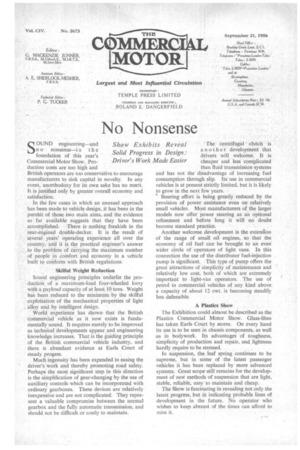No Nonsense
Page 85

If you've noticed an error in this article please click here to report it so we can fix it.
SOUND engineering—and n o nonsense—i s the foundation of this Year's Commercial Motor Show., Production costs are too high and British operators are too conservative to encourage manufacturers to sink capital in novelty. In any event, unorthodoxy for its own sake has no merit. ft is justified only by greater overall economy and satisfaction.
In the few cases in which an unusual approach has been made to vehicle design, it has been in the pursuit of those two main aims, and the evidence so far available suggests that they have been accomplished. There is nothing freakish in the rear-engined double-decker. It is the result of several years operating experience all over the country, and it is the practical engineer's answer to the problem of carrying the maximum number of people in comfort and economy in a vehicle built to conform with British regulations.
Skilful Weight Reduction Sound engineering principles underlie the productiori of a maximum-load four-wheeled lorry with a payload capacity of at least JO tons. Weight has. been reduced to the minimum by the skilful exploitation of the mechanical properties of light alloy and by intelligent design.
World experience has shown that the British commercial vehicle as it now exists is fundamentally sound. It requires merely to be improved as technical developments appear and engineering knowledge increases. That is the guiding principle of the British commercial vehicle industry, and there is abundant evidence at Earls Court of steady progess.
Much ingenuity has been expended in easing the driver's work and thereby promoting road safety. Perhaps the most significant step in this direction is the simplification of gear-changing by the use of auxiliary controls which can be incorporated with ordinary gearboxes. These devices are relatively inexpensive and are not complicated. They represent a valuable compromise between the normal gearbox and the fully automatic transmission, and should not be difficult or costly to maintain. The Centrifugal . clutch is another development that drivers, will welcome. It is cheaper and less complicated than fluid transmission systems and has not the disadvantage of increasing fuel consumption through slip. Its use in commercial vehicles is at present strictly limited, but it is likely to grow,in the next few years.
Steering .effort is being greatly reduced by the provision of power assistance even on relatively small vehicles. Most manufacturers of the larger models now offer power steering as an optional refinement and before long it will no doubt become standard practice.
Another welcome development is the extension of the range of small oil engines, so that the economy of oil fuel• caw be brought to an even wider circle of operators of light vans. In this connection the use of the distributor fuel-injection pump is significant. This type of pump offers the great attractions of simplicity of maintenance and relatively low cost, both of which are extremely important to light-van operators. The use of petrol in commercial vehicles of any kind above a capacity of about 12 cwt. is becoming steadily less defensible.
A Plastics Show The Exhibition could almost be described as the Plastics Commercial Motor Show. Glass-fibre has taken Earls Court by storm. On every hand its use is...to be seen in chassis components, as well as in bodywork. Its advantages of toughness, simplicity of production and repair, and lightness hardly require to be stressed.
In suspension, the leaf spring continues to be supreme, but in some of the latest passenger vehicles it has been replaced by more advanced systems. Great scope still remains for the development of neW methods of suspension that are light, stable, reliable, easy to maintain and cheap.
The Show is fascinating in revealing not only the latest progress, but in indicating probable lines of development in the future. No operator who wishes to keep abreast of the times can afford to miss it.




































































































































































































































































































































